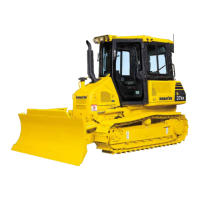.
SAFETY
PRECAUTIONS FOR OPERATION
TRAVELING ON SLOPES
To prevent the machine from tipping over or slipping to the side, always do as follows.
Keep the work equipment approx. 20 to 30 cm (8 to 12 in) above
the ground. In case of emergency, lower the work equipment to
the ground immediately to help stop the machine.
Always travel straight up or down a slope. Traveling at an angle
or across the slope is extremely dangerous.
Do not turn on slopes or travel across slopes. Always go down
to a flat place to change the position of the machine, then travel
on to the slope again.
Travel on grass, fallen leaves, or wet steel plates with low
speed. Even with slight slopes there is a hazard that the
machine may slip.
When traveling downhill, never shift gear or place the
transmission at neutral. It is dangerous not to use the braking
force of the engine. Always place the transmission in a low gear
before starting to travel downhill.
Depress the brake or use the braking effect of the engine as
necessary.
PRECAUTIONS WHEN OPERATING
When using the machine, to prevent personal injury caused by damage to the work equipment or by the machine
overturning due to overloading, do not exceed the permitted performance of the machine or the maximum
permitted load for the structure of the machine.
Be careful not to approach too close to the edge of cliffs. When making embankments or landfills, or when
dropping soil over a cliff, dump one pile, then use the next pile of soil to push the first pile.
The load suddenly becomes lighter when the soil is pushed over a cliff or when the machine reaches the top of
a slope. When this happens, there is danger that the travel speed will suddenly increase, so be sure to reduce
the speed.
If the machine moves with only either side of the blade loaded, its tail may swing. Take care.
TRAVELING ON SNOW-COVERED OR FROZEN SURFACES
Snow-covered or frozen surfaces are slippery, so be extremely careful when traveling or operating the machine,
and do not operate the levers suddenly. Even a slight slope may cause the machine to slip, so be particularly
careful when working on slopes.
With frozen ground surfaces, the ground becomes soft when the temperature rises, and this may cause the
machine to tip over or make it impossible for the machine to escape.
If the machine enters deep snow, there is a hazard that it may tip over or become buried in the snow. Be careful
not to leave the road shoulder or to get trapped in a snow drift.
When clearing snow, the road shoulder and objects placed beside the road are buried in the snow and cannot be
seen. There is a hazard of the machine tipping over or hitting covered objects, so always carry out operations
carefully.
When traveling on snow-covered slopes, never apply the foot brake suddenly. Reduce the speed and use the
engine as a brake while applying the foot brake intermittently (depress the brake intermittently several times). If
necessary, lower the work equipment to the ground to stop the machine.
2 - 26

